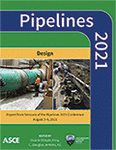Comparison of ASCE’s Unified Approach and Current Practice for Thrust Restraint Design of Segmented Pipelines Using Ductile Iron Pipe as Example
Publication: Pipelines 2021
ABSTRACT
The American Society of Civil Engineers (ASCE) Task Committee on Thrust Restraint Design of Buried Pipelines is currently developing a Manual of Practice (MOP) on the subject under the Pipeline Division of the Utility Engineering and Surveying Institute (UESI). This MOP, currently in its final stages of development, proposes a unified method that can be applied to all common pipe materials used in the water and wastewater industry. This proposed unified approach utilizes advanced soil-structure interaction concepts and consistent soil and pipe-soil interface parameters to better model the conditions of a buried pipeline subjected to thrust forces. The proposed framework consisted of two distinct design solutions: (1) continuous (welded, fused, or flanged) pipelines and (2) segmented pipelines (those with some degree of joint flexibility to allow angular deflection and axial slack) to accommodate the different types of joint types used in practice. Analytical models based on beam on elastic foundation (BOEF) theory were developed to evaluate restrained joint design for each pipeline type. The segmented model incorporates individual beam segments connected by nodes that represent the joints. Each node has six equations in six unknowns; therefore, advanced numerical computational methods are used to obtain the solution. On the other hand, the continuous model is a special case of the segmented model and results in a quadratic equation that can be solved without advanced numerical computational methods. Based on the work completed to-date, the task committee concluded that it would be appropriate and reasonable to solve the segmented pipeline problem as a continuous pipeline to obtain conservative, yet economical restrained lengths for buried pressure pipelines. In order to validate this conclusion, several different problems were analyzed using the numerical models developed for segmented pipelines using both segmented and continuous models, and the results were compared. Due to space limitations, only limited number of thrust restraint analyses and results pertaining to ductile iron pipe, which is a segmented pipe, are presented in this paper. In addition, this paper compares the results obtained from the segmented model with the results obtained using the current thrust restraint design approach contained in the Ductile Iron Pipe Research Association (DIPRA) design guidelines and AWWA design manual M41 for ductile iron pipe.
Get full access to this article
View all available purchase options and get full access to this chapter.
REFERENCES
American Water Works Association (AWWA). (2009). “Ductile Iron Pipe and Fittings”, Manual of Water Supply Practices M41, Third Edition, AWWA, Denver, Colorado.
ASCE Task Committee on Thrust Restraint Design of Pipelines. “Soil Parameters for Assessing Axial and Transverse Behavior of Restrained Pipelines Part 1: Axial Behavior.” Proceedings of the 2014 ASCE Pipeline Division Specialty Conference “From Underground to the Forefront of Innovation and Sustainability”, ASCE, Portland, Oregon, August 2014. (Corresponding Author: Martin W. McCabe).
ASCE Task Committee on Thrust Restraint Design of Pipelines. “Soil Parameters for Assessing Axial and Transverse Behavior of Restrained Pipelines Part 2: Transverse Behavior.” Proceedings of the 2014 ASCE Pipeline Division Specialty Conference “From Underground to the Forefront of Innovation and Sustainability”, ASCE, Portland, Oregon, August 2014. (Corresponding Author: Sri Rajah).
ASCE Task Committee on Thrust Restraint Design of Pipelines. (2013b). “Development of Analytical Model for Thrust Restraint Design – Part 2: Segmented Pipelines.” Proceedings of the 2013 ASCE Pipeline Division Specialty Conference “Pipelines and Trenchless Construction & Renewals: A Global Perspective”, ASCE, Fort Worth, Texas, June 2013. (Corresponding Author: Sri Rajah).
ASCE Task Committee on Thrust Restraint Design of Pipelines. (2013a). “Development of Analytical Model for Thrust Restraint Design – Part 1: Continuous Pipelines.” Proceedings of the 2013 ASCE Pipeline Division Specialty Conference “Pipelines and Trenchless Construction & Renewals: A Global Perspective”, ASCE, Fort Worth, Texas, June 2013. (Corresponding Author: Henry Bardakjian).
ASCE Task Committee on Thrust Restraint Design of Buried Pipelines. (2011a). “Contribution of Lateral Earth Pressure Resistance to Restrain Horizontal Thrust in Buried Pipelines”, In Proceedings of the 2011 ASCE Pipelines Division Specialty Conference “A Sound Conduit for Sharing Solutions”, ASCE, Seattle, Washington, July. (Corresponding Author: Sri Rajah).
Hetenyi, M. (1946), Beams on Elastic Foundation: Theory with Applications in the Fields of Civil and Mechanical Engineering. University of Michigan Press, Ann Arbor, MI.
Rajah, S., McCabe, W.M., and Plattsmier, J. “Classification and Specification of Bedding and Backfill for Buried Water Pipelines.” Proceedings of the 2012 ASCE Pipeline Division Specialty Conference “Innovations in Design, Construction, Operation and Maintenance – Doing More with Less”, ASCE, Miami Beach, Florida, August 2012.
Shumaker, S., and Rajah, S. (2021). “Comparison of ASCE’s Unified Approach and Current Practice for Thrust Restraint Design of Continuous Pipelines –Welded Steel Pipe Example”, Prepared for ASCE Pipelines 2021 Conference. (Accepted for publication).
Information & Authors
Information
Published In
Copyright
© 2021 American Society of Civil Engineers.
History
Published online: Jul 29, 2021
Authors
Metrics & Citations
Metrics
Citations
Download citation
If you have the appropriate software installed, you can download article citation data to the citation manager of your choice. Simply select your manager software from the list below and click Download.
